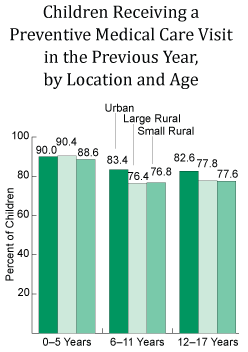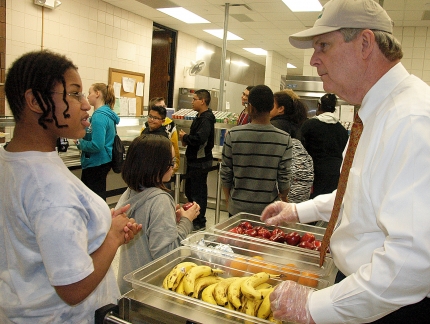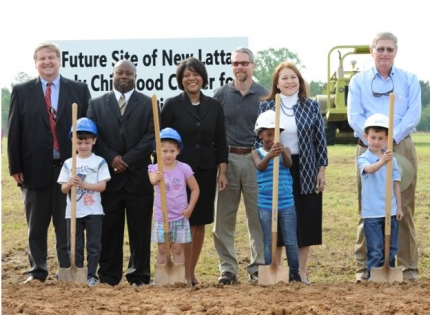Related Rural Blog Posts
Embracing Technology to Support Healthy Kids in Rural America
Posted by on May 7, 2015 at 12:49 PM EDTRural children living in poverty face a range of health and human service needs, yet often lack access to quality clinical and social, human, child development and family support services. The implications are stark. A newly released HHS chartbook shows that rural children face greater health risks and are less likely to get preventive care, compared to their suburban and urban counterparts.

HHS, in partnership with the White House Rural Council's new “Rural Impact” effort to combat rural child poverty, is exploring innovative new strategies to better serve rural kids and families. Today, HHS's Federal Office of Rural Health Policy is announcing new funding to bridge the gap between rural families and critical health and social services. The program—totaling $2.8 million over three years—will support telehealth technology linking children in rural communities to medical specialists and social service resources that may not be available locally.
Imagine: a child living in a remote rural community can be seen and diagnosed for autism over the internet by a specialist based hundreds of miles away.
Or a child with diabetes can receive primary care at their rural health clinic and then connect remotely to an endocrinologist in another city. At the same time, his family can receive nutrition counseling and, if food security is a challenge, be directed to a food bank.
Learn more about Rural$1 Billion Invested in Rural Health Care Across 13 States
Posted by on May 5, 2015 at 1:26 PM EDTEd. note: This is cross-posted on the U.S. Department of Agriculture's blog. See the original post here.
In late 2011, the President announced a White House Rural Council initiative lead by the US Department of Health and Human Services (HHS) and US Department of Agriculture (USDA) to invest in rural health and link rural doctors and hospitals to financing for health IT. The initiative was designed to address the need for financing to support the adoption of health IT systems in rural communities. Financing has been cited as one of the top challenges for rural doctors and hospitals serving remote and poor communities.
Between 2012 and 2014, the HHS and USDA led initiative generated approximately $1 Billion in rural health care financing across 13 states. These investments, funded by USDA, included grants and loans to help rural clinics and hospitals transition from paper to electronic health records (EHRs), encourage exchange of health information with health care providers and patients, and offer telehealth services.
Since it launched in 2012, the initiative has expanded access to financing for rural health care needs through cross-government collaboration and partnerships with non-Government organizations—including bringing together diverse teams to achieve common goals and using existing programs in innovative ways.
Learn more about RuralServing Rural America’s Kids and Families
Posted by on April 13, 2015 at 3:33 PM EDT
Ed. note: This is cross-posted on the U.S. Department of Agriculture's blog. See the original post here.
Every parent’s wish is for their children to thrive and prosper. Yet, too many of our nation’s families still live in poverty, despite doing their best to make ends meet. Rural families and children have additional challenges as schools, health care services, healthy food choices, jobs, and other opportunities are often miles away in a different town, county, or even state. The Obama administration is committed to these families, and believes that all children — no matter where they live — should have an opportunity to succeed.
Today, President Obama and I met with eight members of the National 4-H community in the Oval Office. Each one of them had an inspiring story about how they are opening up new doors for kids in their hometowns, and how this work is building stronger communities where they can learn, play, and grow.
We wanted to take a moment to introduce you to these young leaders and tell you about the projects that encouraged President Obama to invite them to the White House to say “thank you.” Investing in kids like these is an investment in America’s future.
Learn more about RuralOpportunity for All: White House Rural Council Launches “Rural Impact” Effort to Help Rural Children and Families Succeed
Posted by on April 13, 2015 at 12:11 PM EDTPresident Obama believes that every child should have an opportunity to succeed. Yet some rural kids are falling behind—or worse, starting behind. A full 85 percent of our country’s persistent poverty counties are in rural America. Lack of opportunity for rural kids and families is often compounded by other challenges, including distance from health and early learning programs, lack of access to public transportation, and higher rates of drug and substance abuse, among others. But for all kids, the road to successful adulthood relies on a strong foundation of access to basic health, nutrition, high-quality early education, strong schools, and support from parents and caregivers.
Rural Impact is a new effort from the White House Rural Council to address the challenge of rural child poverty by bringing together federal agencies and public and private resources. Rural Impact focuses primarily on a multi-generational approach to how public and private resources are invested in rural families and communities. With support from the President, Cabinet officials, universities, foundations, non-profits and community groups, Rural Impact will focus primarily on three major areas:
- Innovation: Developing new approaches of program delivery, including integrated services and remote health and learning technology, to address rural challenges and barriers;
- Awareness: Enhancing public awareness of rural child poverty and its impact on the future of rural communities and our nation’s global competitiveness; and
- Investment: Improving access to high-quality child care, early learning, and continuing education, and making work pay.
Learn more about RuralInvesting in Rural Kids Is an Investment in Our Future
Posted by on March 2, 2015 at 2:30 PM EDT"Will we accept an economy where only a few of us do spectacularly well? Or will we build an economy where everyone who works hard has a chance to get ahead? ... This country does best when everyone gets their fair shot, everyone does their fair share, and everyone plays by the same set of rules."
-- President Obama, January 31, 2015
The American Dream is a dream of opportunity for a better future. Who better represents this opportunity than our country’s children? As parents and as leaders, we owe it to our kids to provide them access to education, housing and health care, and most importantly, an opportunity to succeed so they can help our nation compete in a 21st century economy.
In small towns and rural communities, kids living in poverty often miss out on these opportunities. They are often isolated and have limited access to support services. School may be miles away, the health care clinic miles in the other direction and the nearest grocery store in yet another direction. Public transportation options are limited, and the family car may be in the shop. Rent might be hard to meet and college might seem to be only a dream.
Our kids are the most important assets we have for building the future economy, and it is essential to make sure rural kids growing up in poverty can reach their full potential. Investing in rural children and their families is critical not just to the long-term success of our rural communities, but to our global competitiveness. Studies indicate that we spend an estimated $500 billion each year on expenses related to child poverty. Imagine if we could use even a fraction of that in smarter ways to serve our children.
Since President Obama convened the White House Rural Council four years ago, we have made tremendous progress in creating new opportunities for rural businesses and communities to thrive and grow. As these opportunities expand, we now need to ensure that they are available to everyone. To that end, the White House Rural Council convened last week to explore how the Administration can better coordinate and target efforts so that rural families living in poverty have the best chance to climb into the middle class.
Learn more about RuralNew Approach to Conservation Creates New Partnerships, New Jobs
Posted by on January 14, 2015 at 5:40 PM EDTEd. note: This is cross-posted on the U.S. Department of Agriculture's blog. See the original post here.
When USDA unveiled the new Regional Conservation Partnership Program last year, I said that this effort would pioneer a new era of conservation. As of today, the program is doing just that — leveraging an unprecedented three-quarters-of-a-billion-dollar investment in projects to preserve clean land and water and create new jobs across the country.
One of the innovative programs in the 2014 Farm Bill, the Regional Conservation Partnership Program brings a wide variety of new partners together — from private businesses, to universities, to local and tribal governments, to non-profit organizations and more — to develop their own action plans and to pledge their own resources to the project. Local organizations are in the driver’s seat, setting priorities and developing conservation projects that make sense for their communities.
The response to this new approach to conservation projects was overwhelming. Earlier this year, when local partnerships submitted their plans to USDA, they requested more than six times the amount of available funding in the first round. This incredible response is a call to action and it shows how much need there is for a program like RCPP.
Learn more about Energy and Environment, Rural
- &lsaquo previous
- 1
- 2
- 3
- 4
- 5
- 6
- 7
- 8
- 9
- …
- next &rsaquo


